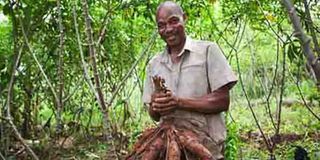Experts mull ‘super cassava’

What you need to know:
The map - scientifically known as high-quality genome assembly – was published after the team thoroughly studied the hereditary material in humans and almost all other organisms (Deoxyribonucleic acid – DNA) sequence information from cassava varieties grown all over the world.
Dar es Salaam. A team of international scientists has published a map with detailed and accurate genetic information that will help to improve cassava production in Tanzania and elsewhere.
The map - scientifically known as high-quality genome assembly – was published after the team thoroughly studied the hereditary material in humans and almost all other organisms (Deoxyribonucleic acid – DNA) sequence information from cassava varieties grown all over the world.
Cassava is a staple food in sub-Saharan Africa – including in Tanzania - yet its yield and quality are compromised by two damaging virus diseases including cassava mosaic disease and cassava brown streak disease.
The evidence provided in the research and the new DNA sequence resources will help scientists to develop varieties that are resistant to these virus diseases.
A statement, circulated by the Dar es Salaam-based International Institute of Tropical Agriculture (IITA), said yesterday that the study results has been published in the April issue of the journal of Nature Biotechnology and goes with title of: “Sequencing wild and cultivated cassava (Manihot esculenta) and related species reveal extensive interspecific hybridisation and genetic diversity”.
Scientists from IITA, University of California, Berkeley, United States Department of Energy Joint Genome Institute (DOE JGI) and from national agricultural research organisations of Tanzania, Nigeria, Fiji, and Micronesia among others, took part in the study.
They sequenced 58 wild and cultivated cassava varieties including related species such as Caera or Indian rubber (Manihot glaziovii), and genotyped 268 African cassava varieties.
Molecular geneticist at IITA-Kenya and co-author of the paper, Morag Ferguson said that the development of genomic resources, such as chromosome scale reference sequence, has increased understanding of the genetic diversity of cassava and its wild relatives, and given insights into its population structure.
“It is expected this will accelerate progress in basic biological research and genetic improvement,” he said.
The study also provided clear evidence to support the hypothesis that cassava was domesticated from a wild species, known as M. esculenta subspecies flabellifolia, in the western part of the southern Amazon region in Brazil, and went through a “genetic bottleneck”, restricting the amount of genetic diversity in cassava.
Head of IITA cassava breeding program at Ibadan in Nigeria Peter Kulakow said that as a clonally propagated crop, genetic improvement of cassava through conventional breeding is a complicated and lengthy affair.
The study provided useful insights into cassava varieties in Africa and their breeding history. The scientists studied varieties from a past cassava breeding program in Amani in Tanzania’s region of Tanga, which was started under the Germans.
After screening cassava from many parts of the world, they were unable to find varieties with high levels of resistance to these diseases, so they started making crosses with wild species including M. glaziovii and “tree cassava”.
According Peter Kulakow, M. glaziovii was introduced in Tanzania during the time of German colonization for rubber production. These trees now grow in the wild, particularly in coastal areas of Tanzania and are an ancestor of “tree cassava” found in many homesteads and on the edge of fields where their leaves are used as a vegetable.
MORE INFO: ORIGINS OF CASSAVA VARIETIES FOUND IN TANZANIA
Sequence information revealed that some of the popular cassava varieties in Tanzania including Namikonga and Muzege, still contain sections of M. glaziovii in their genomes.
Other popular varieties are related and are likely to have been derived from the Amani program include Nachinyaya, Albert, and Kibaha.
When the Amani program closed, many of the varieties were transferred to Mtwapa in Kenya and Moor Plantation in Nigeria.



